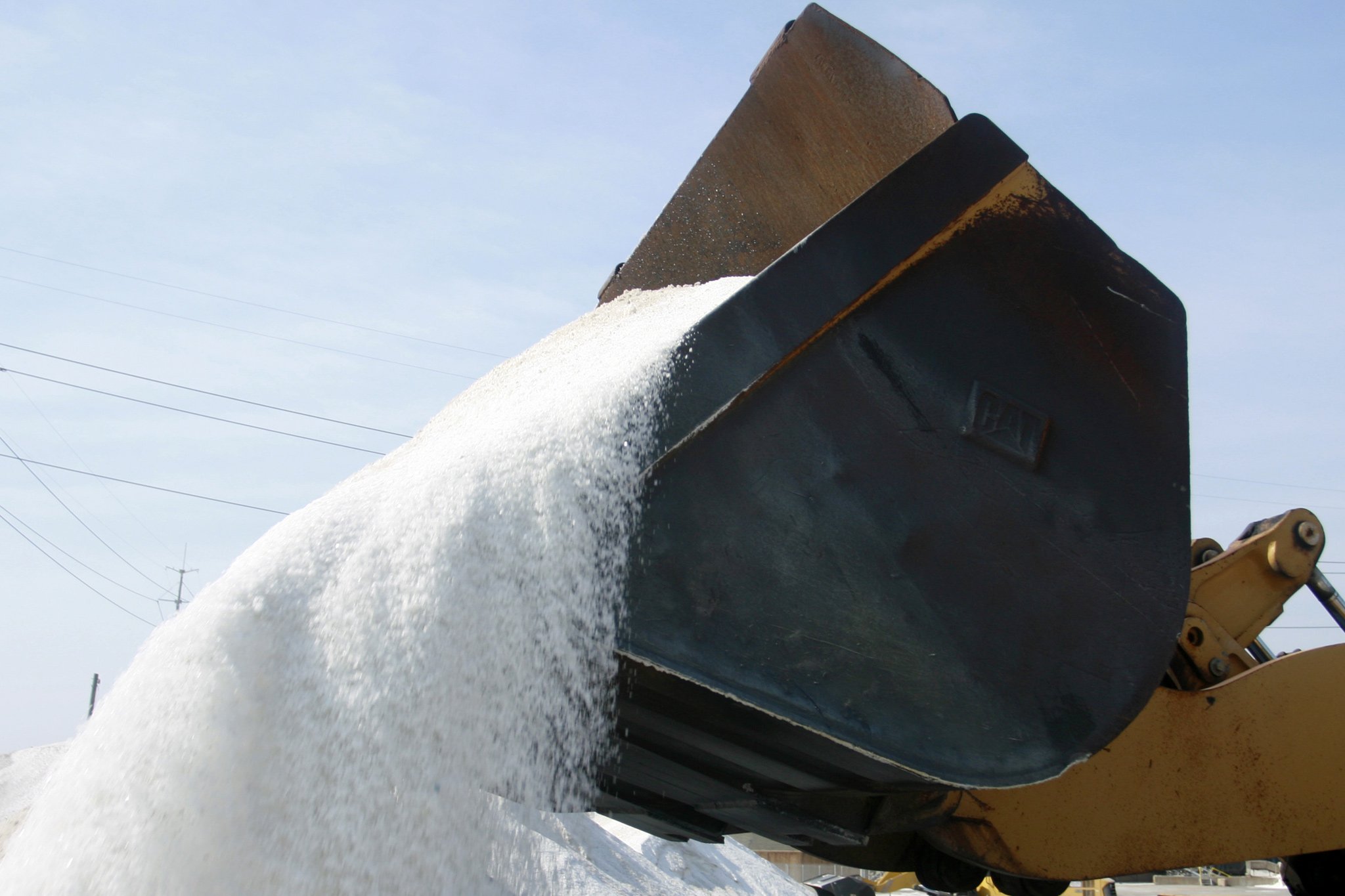
Origins & History
The Origins of Gunther’s Salt Distributors
Louisiana rock salt is on display at the Louisiana Purchase Exposition, better known as the St. Louis World's Fair. This was the exhibit, which included a salt statue of Lot's wife. The Book of Genesis describes how she became a pillar of salt after she looked back at Sodom. Photo taken at the Fair, which ran from April 30 to December 1, 1904.
We trace the origins of the Gunther Salt Company to the turn of the century — when two brothers and eventual salt distributors, Beverly and Frank Myles, sank a shaft to mine salt on Weeks Island, Louisiana.
When the industrial salt mine was ready for production, the Myles brothers came to an agreement with Henry M. Mun, head of the St. Louis-based H.M. Mun & Co. brokerage firm, to market Louisiana rock salt for sale. Concurrently, Joseph J. Gunther became a partner in H.M. Mun & Co.
By 1902, Mun and Gunther jointly owned H.M. Mun & Co. During these early years, the company was a mercantile business. As salt distributors and businessmen, they provided not only salt but a variety of basic food products.
Shortly after, Joseph Gunther acquired Mun's interest in the salt brand. Even so, the company continued to bear the "combined name" of H.M. Mun & Co. and Gunther Salt Company.
Within a few years, the company name transitioned to Gunther Mercantile and, eventually, to Gunther Salt Company, at which time industrial salt became the sole product.
Gunther Salt quickly established itself as an innovator, becoming the first firm to place Louisiana crushed rock salt for sale from a St. Louis base. The salt distributors also had a prominent display at the 1904 World's Fair, introducing visitors to the purity and clarity of Louisiana crushed rock salt.
1930s & 1940s
An employee of Gunther Salt Company is either loading or unloading the Gunther Salt Company truck to make his salt delivery. This photo has a date of August 15, 1922.
Upon the death of Joseph J. Gunther in 1932, responsibility for running the salt brand was assumed by two of his sons — 26-year-old Joseph F. Gunther, Sr., and 23-year-old Gerard K. Gunther. At this time, the company operated from a rental property on the Mississippi Riverfront. Despite lost records from this era, we know sales were quite small. The Great Depression was still ravaging the U.S. — the industrial salt distributors struggled to keep the business whole by pushing rock salt for sale.
In 1934, Gunther began shipping salt from Louisiana by water. A primary screened grade of salt called "mine run" was loaded into shallow draft barges at Weeks Island, Louisiana, and moved through a narrow intercoastal waterway to New Orleans. From there, the salt was transferred across the river to the Federal Barge Line in Algiers, Louisiana, and transported upriver to a terminal at the St. Louis Riverfront, which is still in operation today. The salt was then unloaded and taken to the Gunther warehouse by rail.
A major redevelopment of the St. Louis Riverfront in the early 1940s spurred Gunther’s salt distributors to relocate to a four-story building at the corner of Chouteau and 2nd Street. They adapted the new building for the packaging and distribution of industrial salt by constructing six 60-ton bins and installing a bucket elevator.
At this time, the salt brand’s primary product was granulated salt, which the company received in bulk boxcars, moved by bucket elevator into bins, and then packaged from the bins into cloth bags (typically 100-lb bags). Packed bags were hand-stacked in the warehouse before shipment to customers by truck. Food grade table salt in the familiar round cans was also a fairly significant item, sold in the Gunther label, but packed by Morton Salt Co., at their Hutchinson, Kansas, plant. The market became known as the neighborhood grocery store found on virtually every street corner. Though rock salt was for sale, it had yet to become a significant product for the salt brand — but that was soon to change.
One of the primary uses of industrial rock salt since the early 1900s had been producing brine for ice-making and refrigeration. The development of mechanical refrigeration during the late 1940s caused a decline in the usage of salt for this purpose. By that time, emerging demand for water softeners — which require salt for mineral regeneration — opened up a profitable new market for salt distributors.
Water softening required a low-cost salt product, ideally produced from the high-purity rock salt mines of southern Louisiana. Gunther Salt was well-positioned for water softening, and its rock salt for sale was pushed into an unforeseen market: road de-icing.
1950s & 1960s
For most of it's history, Gunther Salt Company was located at 2nd Street and Chouteau Avenue near the south leg of the Gateway Arch. These buildings are still standing.
The market for de-icing city streets in winter was growing, and industrial rock salt was an obvious choice for meeting this need. With the construction of the interstate highway system in the 1950s, the demand for de-icing rock salt would grow dramatically.
The mid-1950s saw two more family members come into the salt brand. J. Barry Gunther (son of Joseph F.) and Gerard Gunther (son of Gerard Sr.), following military service, took positions at Gunther Salt — both spending their time exclusively in sales. By 1959, the company had three other salt distributors: Fred Kramer in southern Illinois, Cecil Banta in outstate Missouri, and Elzie Gardner in central Missouri. Banta and Gardner sold industrial salt products primarily from the Morton granulated plant in Hutchinson, Kansas, and the Independent Salt Company rock salt mine in Kanopolis, Kansas. Both plants packaged salt in Gunther-branded bags, as well as processed bulk shipments to Gunther accounts. With rock salt for sale among other varieties, the salt brand’s annual sales were in the range of $1,500,000.
With the growth of the rock salt business in the early 1960s, the company found itself in need of more storage capacity. This was filled with the acquisition of a former City Products ice-house at the corner of 6th and La Salle Streets. This represented a major improvement for salt distributors since the building could accommodate about four barge-loads of industrial salt (approximately 6,000 tons).
Although the major market for tonnage sold out of the warehouse was limited to a 50-mile radius, the outstate business was steadily growing, thanks to municipal water-softening and water-softener dealership expansion. Rock salt for sale was virtually the only product used by these markets.
In the late 1960s, alternative salt products for the water softening industry came into the market in the form of granulated pellets and "pseudo"-pellets. Though priced higher than rock salt, these products boasted greater purity and "100%" solubility compared to rock salt. These products made significant inroads into the market and were promoted aggressively by salt distributors. A short time later, solar salt began to appear on the market, soon establishing itself in the hierarchy between rock salt and evaporated (pellet) salt.
As the 1960s drew to a close, St. Louis boasted warehouses owned by four major industrial salt brands: Gunther Salt Co., Morton Salt Co., International Salt Co., and Hardy Salt Co.
1970s & 1980s
In the early 1970s, Diamond Crystal Salt Company of St. Clair, Michigan approached Gunther Salt with a request for solar, evaporated, and rock salt for sale in a wide geographic area of the Midwest. Gunther Salt agreed, entering into a ten-year arrangement that would prove both beneficial and profitable. It also represented the first time Gunther’s salt distributors marketed products without the Gunther brand identity.
The 1980s saw consolidation in the salt industry. Hardy Salt, a St. Louis-based brand, was acquired by Diamond Crystal Salt — Diamond Crystal Salt was subsequently acquired by International Salt. Soon, International Salt was purchased by the Dutch chemical company, Akzo. A Louisiana rock salt mine that had been developed jointly by Carey Salt Company and Monsanto was acquired by Domtar, a Canadian chemical company. The purchase price of the industrial salt mine was nearly $9 million. Before the end of the decade, Akzo's U.S. salt business was acquired by Cargill.
The 1980s also saw a new player enter the market. This was entrepreneur George Harris, who created the new North American Salt Company out of an assemblage of assets comprising the American Salt Company plant producing evaporated salt in Kansas, the Louisiana mine producing rock salt for sale owned by Domtar, and the Great Salt Lake plant producing solar salt.
In 1985, Gerard Gunther, Jr. and Barry Gunther purchased from their fathers the operating assets of Gunther Salt Company. Under the new ownership, the salt brand’s expansion and property acquisition that began decades earlier continued. Through the rest of the 80s and into the 1990s, the industrial salt distributors acquired both land and buildings; the most significant purchase was on Buchanan Street, where a new 12,000-ton capacity salt dome was built. Gunther's acquisitions included expanded warehousing, truck scales, and exterior space for over 50,000 tons of bulk ice control salt. The expansion allowed increased production capacity for solar, evaporated, and rock salt for sale
Also, in 1985, Gunther Salt Company relocated. The St. Louis riverfront has been home to Gunther Salt Company since the 1940s when offices moved to the corner of Chouteau and 2nd Street near the south leg of the Gateway Arch. In 1985, the salt brand relocated to 101 Buchanan Street — two miles north of the Arch and just north of downtown.
1990s to Present Day
Current Gunther Salt Company president, John Gunther, joined the company in 1991.
By the mid-1990s, the surviving major national salt distributors and producers in the U.S. were Morton, Cargill, and North American. A smaller regional producer was the United Salt Company of Houston, Texas (a privately-owned producer of industrial evaporated salt and solar salt). The primary effect of this consolidation on Gunther Salt Company was that the number of its potential suppliers was reduced from five to three. This made for a more difficult competitive environment around the solar, evaporated, and rock salt for sale.
In 2002, Gerard Gunther, Jr. bought out the interest of Barry Gunther and became the sole owner of Gunther Salt. By then, Gerard, Jr.'s sons, Gerard III and John, were also employed by the salt brand. Four years later, in 2006, the company purchased the adjacent Morton Salt Company warehouse, bagging line, and salt dome. This gave the Gunther Salt Company facility a total operating area of 11+ acres along with some 100,000 sq ft of storage buildings. These facilities maintain solar, evaporated, and rock salt for sale to this day.
In 2006, Peter Gunther, the youngest of Gerard Jr.'s three sons, began working at the company. In 2010, Gerard III, John, and Peter bought out Gerard Jr. who now serves as a consultant to Gunther Salt Company. The family legacy continues as they each take their places as industrial salt distributors, business leaders, and consultants.
Today, Gunther Salt Company has three salt domes, three warehouses, and two packaging lines, comprising a total operating area of 11+ acres along with some 100,000 sq ft of storage buildings. Gunther Salt Company's plant is conveniently located just off Interstate I-70 and close to Interstates I-44, I-55, and I-64.





